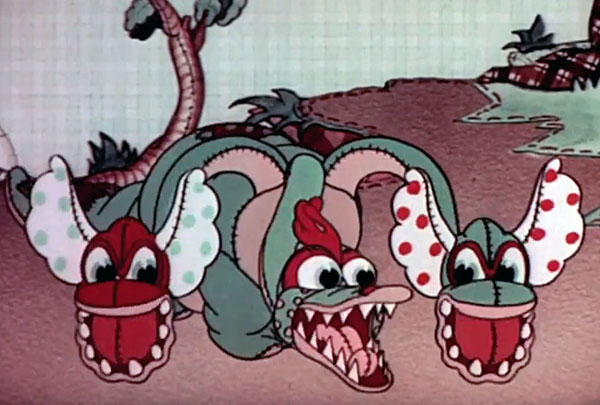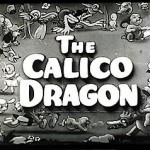
For our last installment of Fairy Tale February, here’s an Oscar-nominated cartoon from the Harman-Ising studios!
Throughout the 1930s, the animated films nominated for an Academy Award, up against Disney’s cartoons, bore inclinations to their competition to utilize that appeal. The cartoons’ Disney-esque fantasias seemed to appease the Academy voters, though it appears animation studios whose cartoons proliferated with eccentricities, like Ub Iwerks’ outfit and the Van Beuren Corporation, never received a nomination. Individuality from the non-Disney studios, which veered away from the norm, was an anomaly— the two 1936 nominees Popeye Meets Sindbad the Sailor (Fleischer) and The Old Mill Pond (Harman-Ising), along with Tex Avery’s Detouring America (Warners, 1939) are such examples. In the case of Harman and Ising’s studio, their former association with Disney was necessary to compete with him—more so for Harman.
The settings in Ising’s The Calico Dragon—filmed in the two-colorThe start/finish dates for scene assignments are incomplete, but the animation for Calico Dragon occurred, at least, from January 17 through February 14, 1935. Much of the footage for this film is given to animator Bob Allen, who handles two extensive portions, among his other credited scenes. He animates the little girl reading her storybook aloud to her dolls in the opening, and the lengthy song sequence from the three-headed Calico Dragon later in the film.
Jim “Tony” Pabian animates much of the boy doll and his horse on the girl’s quilt, before they embark on their quest. Pabian later handles the boy and horse charging after the dragon with his peppermint candy lance during the fight sequence. Pete Burness animates most of the scenes with the terrier dog. Burness handles the dog joining the boy and his horse to their journey, and later, during the battle scenes, he animates the dog being scared off by the dragon’s tongue, which uncoils like a party horn. Burness animates the dog re-entering the fight, twisting their three heads into a knot, and being swallowed by the dragon.Cal Dalton animates the dog chasing after the “little rag bunnies” early in the film, and being spanked by their ears to the tune of Johann Strauss’ “Blue Danube Waltz.” Other animators on this film, credited on the draft, are Bob Stokes, Tom McKimson, Carl Urbano, Gil Turner, Frankie “Franswaw” Smith, and Joe D’Igalo—credited for only one scene, of the dog scaring the dragon back to its castle with its detached tongue.

The Calico Dragon was released March 30, 1935; given the film’s short period between animation and its release date, there are no existing story notes to discern when production began, or if the Cinecolor film process, after the photography, took up much of the schedule. The film was nominated along with Disney’s Who Killed Cock Robin, and lost to another Silly Symphony, Three Orphan Kittens. In the draft, scene 6 is credited to Jim Pabian and Bob Stokes, but it’s unclear if there is an animation switch in the midst of the sequence, or if Pabian and Stokes worked together. If anything, the scene is more consistent with Pabian’s drawing/animation in the rest of the finished film.
Hope you’ve all enjoyed “Fairy Tale February.” After this post, I will be taking a brief hiatus from Cartoon Research. It might give me some extra time to do some additional research, and engage in certain artistic endeavors I’ve held off on for a long time. (As a creative person with maybe too many passions, I’ve had many script ideas, notions of making a comic book series and looking into writing a different series of articles for CR, of which will need much assistance.)
It’s been almost two years since I’ve shared my posts on here, and I always look forward to the reactions from all of you every week. Two posts after this week’s installment will be my 100th post—counting the animator breakdowns and comic book profiles—so it might be necessary to prepare something special during the hiatus.
Enjoy the video! I’ll be back before you know it…

(Thanks to Michael Barrier and Frank Young for their help.)




 DEVON BAXTER is a film restoration artist, video editor, and animation researcher/writer currently residing in Pennsylvania. He also hosts a
DEVON BAXTER is a film restoration artist, video editor, and animation researcher/writer currently residing in Pennsylvania. He also hosts a 



















































































Love these breakdowns! I’ll miss your articles, but good luck on your endeavors.
I’ve seen this many years ago. It’s very good…any ideas about who did the little girls voice (Bereneice Hansel, probably)? MGM in Cinecolor….forgot about that..! I’ll miss the posts for now….
Boy, that is a wonderful little film!
Loved the Calico Dragon including the scene where the toy Scottie was swallowed by the Calico Dragon but escaped thru a patch on the Dragon rear leg with the noisemaker tongue that belong to one of the Dragon’s mid head and used it to spook the dragon causing him to jump wailing in terror and causing a hole into the fabric which swallowed the dragon whole.
Thanks Devon. The breakdowns have been great, as have your writings in general.
Best of luck.
I’ll miss your posts for a while Devon, but I know you’ll have some classic juicy installments when you return.
Though I wonder who’s going to fill this slot starting next week..
By the time we got to meet the dragon it was filled with DVNR, especially the dragon’s noise maker-like tongue………
With the possible exception of the lone Tom and Jerry Golden Collection, MGM cartoons on WB DVDs are LOADED with DVNR!
It is seldom that the Academy Award nominees of the 1930’s are talked about. Even on the otherwise fantastic ACADEMY AWARD WINNERS AND NOMINEES collection, previously released by Warner Home Video, we only get the Max Fleischer entries, omitting both this cartoon and a Harman/Ising entry from their LOONEY TUNES days, “IT’S GOT ME AGAIN”. I am delighted to hear so much detail about this cartoon and, yes, its overall look impressed me as well, and I’d only seen a grainy black and white print on local TV. I don’t say I know all the facts, but I’m nearly sure that Berniece Hansel did not do the voice of the little girl reading. I would assume that the voice is the same as the voice of Honey in MGM Bosko cartoons like “CIRCUS DAZE” and “THE OLD HOUSE” or the little cold-in-the-nose squirrel in an earlier Hugh Harman effort, “POOR LITTLE ME”.
I remember the spread on the bed having an intricate design which neatly moved whenever the spread was ruffled during the fracous; yet, you could almost reimagine the ruffled folds of the spread as rolling hills on which such a batttle would take place. For its look alone, the cartoon should have walked away with the award. And what an irony that the Harman/Ising MGM cartoon, “THE MILKY WAY” would be the duo’s first win over Disney, whereas the Disney team, in 1936 won for their own three kittens cartoon. Thanks, Devon, for this, and I hope you do return to this blog real soon with more interesting 1930’s breakdowns. I still wish that someone would do an analytic overview of the MGM studios.
The one thing that cannot be disputed is that the MGM cartoon looked so good, right up to the end–and the 1930’s boasted some of the most elaborate animation ever seen in an animated cartoon, even if it isn’t as adept at story-telling and timing as the Walt Disney version. There were times when Harman’s use of “streak” or brush lines could almost be seen as short cuts because you would imagine that they were constantly being chastized for the exorbitant detail and special effects to enhance even the simplest story line.
Hi Devon,
Great post, we’re going to miss you around here. I don’t think that this cartoon was shot in Cinecolor, but two-color Technicolor (red and green). All the other Harman-Ising Happy Harmonies were shot in Two-color Tech., until The Old Plantation, the first three-color Technicolor Harman-Ising cartoon.
This cartoon features a favorite Harman-Ising bit, the party favor gag. The party favor in the thirties was a paper roll that puffed out when the user blew into it, unrolling until the noise maker at the end sounded off. In The Calico Dragon, you can hear the sound of crinkly paper when the dragon’s “tongue” rolls back into it’s head. There are several other Happy Harmonies that used the party favor gag, and the little vibrating sound that went with it.
I’ll be missin’ your breakdowns, also, Devon.
Thought I saw every classic and vintage cartoon out there – but I never saw The Calico Dragon. Thanks Cartoon Research!
When I find it, I’ve a animation drawing of the dog at the start of when he barks on the blanket near the start of the short of which I love …..for alla right reason of course…heh…so stay toned in more ways than one when I find it….!…and hope to show it here for ya.